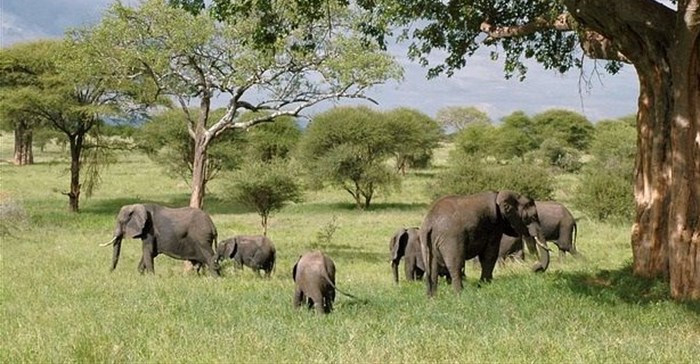What camera traps tell us about elephants eating crops

One of the major challenges to coexistence is the use of food crops by elephants. This threatens the livelihoods, food security and well-being of rural communities. Elephant forays into farmland sometimes results in retaliatory and legal killings under the Problem Animal Control laws and erosion of support for elephant conservation efforts.
For people and elephants to thrive in the long-term, it’s important to find ways to mitigate the impact of the animal on people’s lives and livelihoods and vice versa. To find effective solutions, we need to understand why elephants eat crops rather than fodder from the bush and how they learn about crops as a source of food.
To explore these questions our team at the Southern Tanzania Elephant Program used camera traps to capture elephant visits to farmland. The cameras were set up in an area adjacent to the Udzungwa Mountains National Park in Tanzania between 2010 and 2014.
We placed camera traps on elephant trails on the National Park boundary to photograph elephants as they travelled in and out of neighbouring farmland. We then studied the camera trap photos to identify individual elephants from key distinguishing features like ears and tusks.
High-risk, high-reward
All the elephants photographed by our camera traps were males. This is consistent with previous studies suggesting that eating crops is a high risk, high reward feeding strategy for males. Females have been documented to feed on crops, but they are generally less likely to visit farms because of the risks involved to their young.
Age also plays a role. Our study, as well as previous studies in Amboseli, Kenya and Kibale, Uganda found that eating crops appears related to specific milestones in a male elephant’s life.
Two particular milestones stood out: the start of reproduction in bulls when they reach the ages of between 20-30 years and their reproductive peak years in their 40s. When males reach these milestones, they are more willing to take risks and have increased energetic demands. Crops are an attractive source of food for males seeking to maximise their body size and reproductive success.
How do males learn about crops as a food source? In Udzungwa, we found that young bulls aged 10-14 years visited farms. This is the age when males typically leave their maternal family groups, so they may be discovering farms during the process. It’s also possible that they learn about crops from older elephants. Researchers in Amboseli found that young bulls learnt about crops from older bulls and that male social networks shaped behaviour.
How many eat crops?
Some studies have investigated how many bulls eat crops, and how their feeding habits vary. In Udzungwa we identified 48 different elephants from our camera trap photos. With so many bulls visiting the farmland in our study site, we couldn’t attribute the crop damage to just a few habitual males.
We also found that the frequency of visits varied between individual bulls. Two-thirds were seen only once over the four-year study period, suggesting that these bulls visit farms infrequently. One-third of the bulls were seen multiple times and 18% more than twice over the study period. These males may be using crops more regularly. But even among these repeat offenders, males varied considerably in how often they visited farms.
In Kenya by comparison, researchers estimated that 12% of Amboseli bulls and 21% of bulls from the wider Amboseli, Kilimanjaro and Tsavo-Chyulu populations were repeat crop eaters. Combined, this evidence suggests that the majority of bulls occasionally use crops, while a small proportion may use them more frequently.
Strategies
Strategies to reduce crop losses to elephants should consider that most bulls consume crops infrequently. So, killing elephants for eating crops is unlikely to significantly reduce crop loss. Taking lethal action is also costly, for it affects those older bulls who are more likely to be eating crops. Killing these older bulls removes a crucial source of ecological knowledge as well as important breeding individuals. This is particularly damaging to elephant populations already under threat from ivory poaching.
![]() There are much better non-lethal options for reducing crop losses to elephants. These include beehive fences and land use planning which involves carefully assessing land for the best possible use. These approaches require strong commitment, community buy-in and creativity. But, as we’ve found in our work in Tanzania, they offer promising avenues for improving the chances of farmers and elephants being able to coexist.
There are much better non-lethal options for reducing crop losses to elephants. These include beehive fences and land use planning which involves carefully assessing land for the best possible use. These approaches require strong commitment, community buy-in and creativity. But, as we’ve found in our work in Tanzania, they offer promising avenues for improving the chances of farmers and elephants being able to coexist.
This article was originally published on The Conversation. Read the original article.
Source: The Conversation Africa

The Conversation Africa is an independent source of news and views from the academic and research community. Its aim is to promote better understanding of current affairs and complex issues, and allow for a better quality of public discourse and conversation.
Go to: https://theconversation.com/africa












